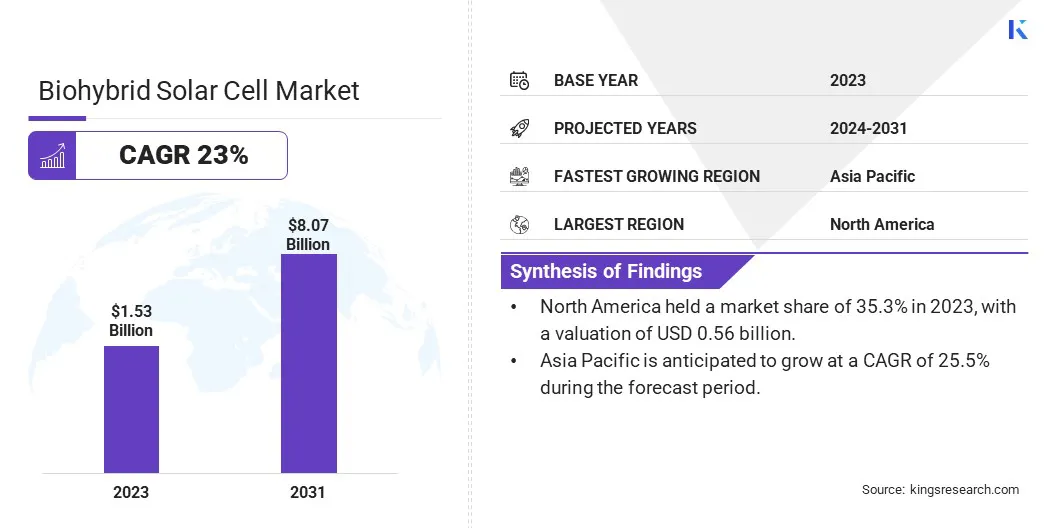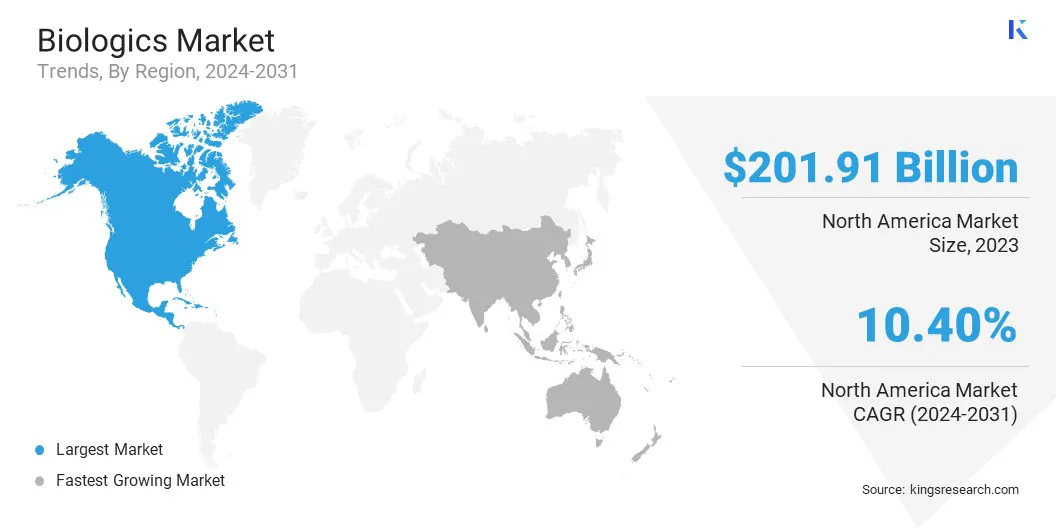Biohybrid Solar Cell Market: Global Share and Growth Trajectory
The global biohybrid solar cell market size was valued at USD 1.53 billion in 2023 and is projected to grow from USD 1.90 billion in 2024 to USD 8.07 billion by 2031, exhibiting a CAGR of 23% during the forecast period.
The global market is witnessing significant growth. This is due to high demand for renewable energy, advances in photovoltaic technology, and the need for sustainability. Biohybrid solar cells combine biological components with traditional solar cells. They use both natural photosynthesis and artificial energy conversion.
This offers a unique way to generate energy. These cells are an innovative solution. They aim to improve the efficiency, sustainability, and cost-effectiveness of solar energy production.
The rise in clean energy is driving the market. As nations seek to cut carbon emissions and hit renewable energy goals, biohybrid solar cells offer a better option than traditional solar technologies. These solar cells integrate biological elements, like bacteria and algae, with inorganic photovoltaic materials. They can boost energy conversion and reduce the environmental impact of traditional solar panels.
Tech advancements are also key to the growth of the biohybrid solar cell market. Researchers and manufacturers are working to improve biohybrid cells. Recent breakthroughs in bio-inspired designs and bio-electrochemical processes aid this effort.
These innovations are making biohybrid solar cells better. They are now more efficient, long-lasting, and viable for sale. Also, scaling these technologies for larger applications opens up new avenues for their use in various industries. This includes both small devices and large solar farms.
The market is growing. There is a rising demand for sustainable, eco-friendly tech in agriculture, transportation, and construction. Biohybrid solar cells can create low-impact, self-sustaining energy sources. They are ideal for off-grid, remote areas and autonomous devices. Also, their use in wearable devices could revolutionize energy storage in electronics.
As the world pushes for cleaner energy, the market should grow rapidly. Ongoing research and the global rise of renewable energy make biohybrid solar cells a promising solution for future solar energy. The expansion of the market is a direct result of the ability of biohybrid cells to lower dependence on traditional energy. This contributes to the global shift toward a more sustainable, green energy future.

What are the major trends in this market?
The market is marked by innovation and research. There is a rising demand for cleaner energy solutions. Key trends driving market growth include:
- Sustainability Focus: Biohybrid solar cells use biological materials. They may lower the carbon footprint of solar energy production. This has made them popular. As energy policies worldwide focus on sustainability, biohybrids are gaining traction.
- Advancements: Combining biological components, like photosynthetic bacteria and algae, with traditional solar cells is boosting their efficiency and energy conversion rates.
- Cost-Effectiveness: Biohybrid solar cells should cut manufacturing costs. This will make solar energy more accessible for residential, industrial, and commercial use.
- Lightweight and Flexible Designs: Biohybrids use a mix of organic and inorganic materials. This makes solar cells more flexible and lightweight. They could be used in places where traditional solar panels do not work.
- Energy Efficiency: Biohybrid solar cells can convert and harvest energy better. They can boost solar power systems' overall efficiency.
Major Players and their Competitive Positioning
The biohybrid solar cell market is still emerging. But, key players are driving innovation and commercialization. They include research institutions, energy companies, and startups. These players are developing biohybrid tech to compete with conventional solar energy solutions.
Consumer Behavior Analysis
Consumers are increasingly adopting renewable energy solutions due to:
- Environmental Concerns: Rising awareness of climate change is driving a shift to cleaner energy. Consumers are looking for alternatives to conventional sources. This includes biohybrids.
- Long-Term Savings: Biohybrid solar cells may cut manufacturing costs. They are expected to provide cheap solutions for both large-scale and residential energy systems.
- Sustainability Demand: There is a growing demand for sustainable products. Biohybrids meet this demand and offer high performance.
Pricing Trends
Biohybrid solar cell prices depend on research and technology progress. Biohybrids are now pricier than traditional solar cells due to their newness. But, as technology improves and production scales, prices should drop. This will make biohybrids more accessible.
What is the market scenario in North America and Asia-Pacific region?
North America accounted for around 35.3% share of the biohybrid solar cell market in 2023, with a valuation of USD 0.56 billion. Energy demand is rising and so is the need for sustainable, renewable energy. This is driving investment in solutions like biohybrid solar cells.

Asia Pacific biohybrid solar cell market is poised to grow at a CAGR of 25.5% through the projection period.
What are the major factors driving this market?
Several key factors are driving the growth of the market:
- Advancements in Biotechnology: Crafting more efficient biohybrid materials has the capability to improve biohybrid cells' energy conversion efficiency.
- A Rise in Renewable Energy Use: Global energy demand is rising and so is the need for sustainable, renewable energy. This is driving investment in solutions like biohybrid solar cells.
- Government Support: Worldwide, governments are offering incentives for clean energy. These will boost biohybrid solar cell adoption.
Regulatory Landscape
As governments impose stricter sustainability rules, biohybrid solar cells face new regulations. Biohybrid R&D must meet these standards. This will ensure mass adoption and regulatory support.
Recent Developments/Market Highlights
The market is seeing several developments, including:
- Hybrid Materials Integration: Research is underway to combine organic materials with inorganic compounds. The goal is to boost solar cell efficiency and longevity.
- Enhanced Efficiency: Ongoing studies aim to improve biohybrids' energy conversion rates by optimizing biological materials.
- Commercialization Efforts: Research institutes are increasing efforts to market biohybrid solar cells.
Current and Potential Growth Implications
Demand Supply Analysis
The demand for biohybrid solar cells will rise. This is due to a growing need for sustainable energy. However, the supply of raw materials for biohybrids may pose short-term challenges. So may the scalability of their production.
Gap Analysis
The biohybrid solar cell market has made progress. But, some areas need more work.
- Material Stability: A key challenge is the long-term stability of biological components in biohybrid solar cells. It must be addressed to ensure consistent performance.
- Manufacturing Scalability: Manufacturers operating in the market must scale up biohybrid production. It must be high-quality and efficient. This is key to meeting the global demand for sustainable energy.
Top Companies in the Biohybrid Solar Cell Market
- Heliatek GmbH
- First Solar, Inc.
- SunPower Corporation
- SolarWindow Technologies, Inc.
- Oxford Photovoltaics Limited
- Solaronix SA
- Dyesol Limited
- Mitsubishi Chemical Corporation
- Sharp Corporation
- Panasonic Corporation
Biohybrid Solar Cell Market: Report Snapshot
| Segmentation |
Details |
| By Technology |
Organic Biohybrids, Inorganic Biohybrids, Hybrid Biohybrids |
| By Application |
Residential, Commercial, Industrial |
| By Region |
North America: U.S., Canada, Mexico |
| Europe: France, UK, Spain, Germany, Italy, Russia, Rest of Europe |
| Asia-Pacific: China, Japan, India, Australia, ASEAN, South Korea, Rest of Asia-Pacific |
| Middle East & Africa: Turkey, U.A.E., Saudi Arabia, South Africa, Rest of Middle East & Africa |
| Latin America: Brazil, Argentina, Rest of South America |
High Growth Segments
- Organic Biohybrids: These are expected to grow at a heightened pace owning to their affordability and sustainable nature.
- Residential Solar Cells: Consumers want greener energy for their homes. Therefore, demand for residential solar cells will grow.
Major Innovations
Innovation is a driving force in the market. Some of the latest innovations include:
- Efficient Biohybrid Combinations: Researchers are exploring new mixes of biological and non-biological materials to boost the energy output of biohybrid cells.
- Eco-Friendly Manufacturing: New processes are being developed to enhance the sustainability of biohybrid manufacturing. They will reduce the production's environmental impact.
Potential Growth Opportunities
The market is still developing. There are challenges and opportunities ahead.
- R&D Investment: More R&D will speed up the development of better biohybrids.
- Technological Barriers: Fixing current technology issues, like stability and scalability, will unlock the market's full potential.
- Environmental Awareness: Growing concern for the environment will boost demand for biohybrid solar cells as a cleaner energy source.
Kings Research says:
The global biohybrid solar cell market will grow significantly in the coming years. This growth will come from new technologies, a shift to sustainable energy, and greater environmental awareness. Companies that can solve R&D and commercialization challenges will thrive. They must also leverage the growing interest in eco-friendly energy solutions in this dynamic market.


